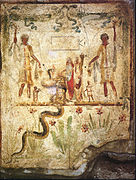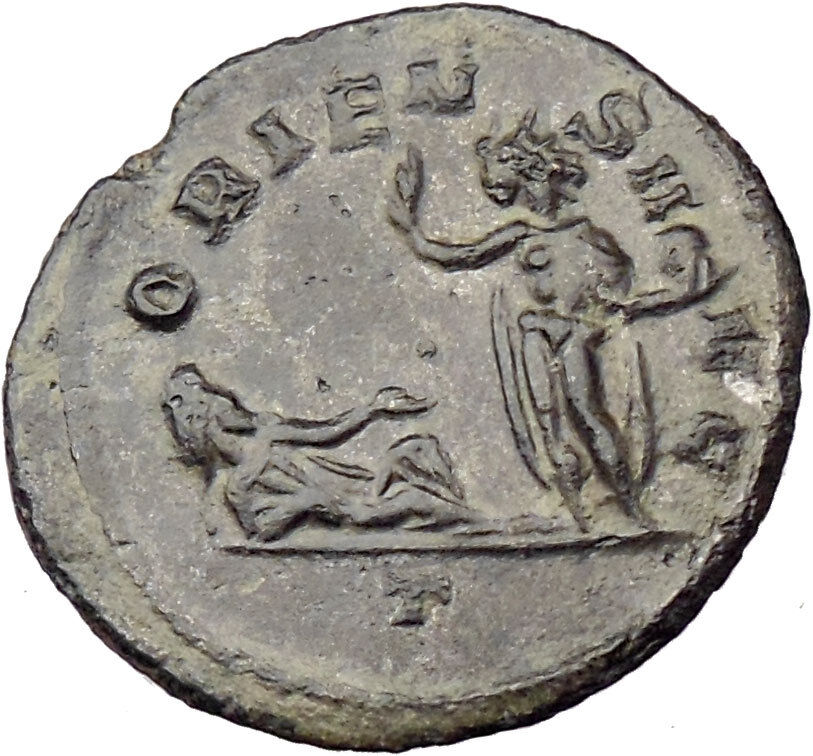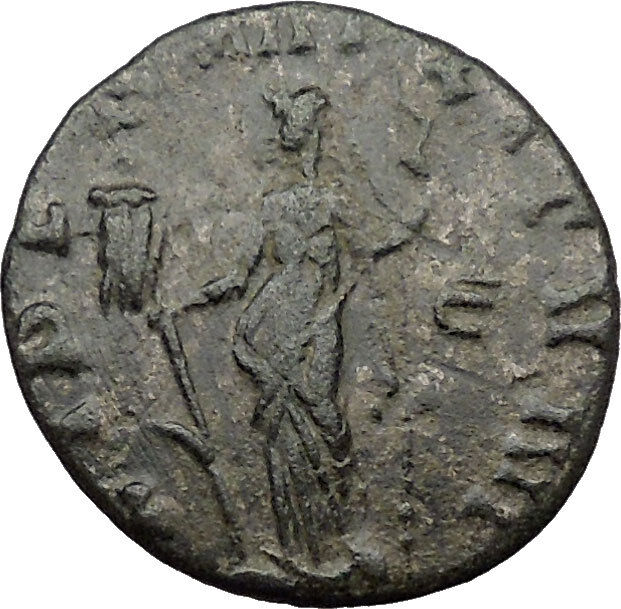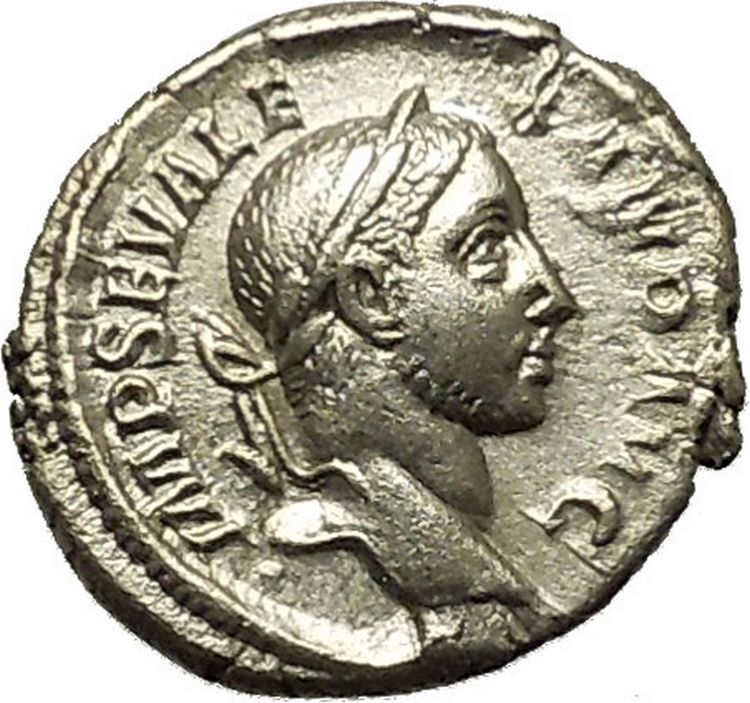|
Maximinus II ‘Daia’-
Roman Emperor
: 308-313 A.D. –
Bronze Follis 22mm (5.81 grams) Antioch mint 310-311 A.D.
Reference: RIC 147v (VI, Antioch)
IMPCGALVALMAXIMINVSPFAVG – Laureate head right.
GENIOEXERCITVS Exe: crescent/Δ/.ANT – Genius standing left, sacrificing over
altar and
holding cornucopia.
You are bidding on the exact item pictured,
provided with a Certificate of Authenticity and Lifetime Guarantee of
Authenticity.
The modius is a type of flat-topped cylindrical
headdress or crown found in
ancient Egyptian art
and art of the
Greco-Roman world
. The name was given by modern
scholars based on its resemblance to the basket used as a
Roman unit of dry measure
.
The modius is worn by certain deities, including
Mut,
Eleusinian deities
and their Roman
counterparts, the
Ephesian Artemis
and certain other forms of the
goddess, Hecate
, and
Serapis
. On some deities it represents
fruitfulness.
A tall modius is part of the complex headdress used for portraits of Egyptian
queens, ornamented variously with symbols, vegetative motifs, and the
uraeus
.[6]
It was also the distinctive headdress of
Palmyrene
priests.
The cornucopia (from Latin cornu copiae) or
horn of plenty is a symbol of abundance and nourishment, commonly a large
horn-shaped container overflowing with produce, flowers, nuts, other edibles, or
wealth in some form. Originating in
classical antiquity
, it has continued as a
symbol in
Western art
, and it is particularly associated
with the
Thanksgiving
holiday in
North America
.

Allegorical
depiction of the Roman
goddess
Abundantia
with a cornucopia, by
Rubens
(ca. 1630)
In Mythology
Mythology
offers multiple
explanations of the origin
of the cornucopia.
One of the best-known involves the birth and nurturance of the infant
Zeus, who had to be hidden from his devouring father
Cronus
. In a cave on
Mount Ida
on the island of
Crete
, baby Zeus was cared for and protected by
a number of divine attendants, including the goat
Amalthea
(“Nourishing Goddess”), who fed him
with her milk. The suckling future king of the gods had unusual abilities and
strength, and in playing with his nursemaid accidentally broke off one of her
horns
, which then had the divine power to
provide unending nourishment, as the foster mother had to the god.
In another myth, the cornucopia was created when
Heracles
(Roman
Hercules
) wrestled with the river god
Achelous
and wrenched off one of his horns;
river gods were sometimes depicted as horned. This version is represented in the
Achelous and Hercules
mural painting
by the
American Regionalist
artist
Thomas Hart Benton
.
The cornucopia became the attribute of several
Greek
and
Roman deities
, particularly those associated
with the harvest, prosperity, or spiritual abundance, such as personifications
of Earth (Gaia
or
Terra
); the child
Plutus
, god of riches and son of the grain
goddess Demeter
; the
nymph
Maia
; and
Fortuna
, the goddess of luck, who had the power
to grant prosperity. In
Roman Imperial cult
, abstract Roman deities who
fostered peace (pax
Romana) and prosperity were also depicted with a cornucopia,
including Abundantia
, “Abundance” personified, and
Annona
, goddess of the
grain supply to the city of Rome
.
Pluto
, the classical ruler of the underworld in
the
mystery religions
, was a giver of agricultural,
mineral and spiritual wealth, and in art often holds a cornucopia to distinguish
him from the gloomier Hades
, who holds a
drinking horn
instead.
Modern depictions
In modern depictions, the cornucopia is typically a hollow, horn-shaped
wicker basket filled with various kinds of festive
fruit
and
vegetables
. In North America, the cornucopia
has come to be associated with
Thanksgiving
and the harvest. Cornucopia is
also the name of the annual November Wine and Food celebration in
Whistler
, British Columbia, Canada. Two
cornucopias are seen in the
flag
and
state seal
of
Idaho
. The Great
Seal
of
North Carolina
depicts Liberty standing and
Plenty holding a cornucopia. The coat of arms of
Colombia
,
Panama
,
Peru and
Venezuela
, and the Coat of Arms of the State of
Victoria, Australia
, also feature the
cornucopia, symbolising prosperity.
The horn of plenty is used on body art and at Halloween, as it is a symbol of
fertility, fortune and abundance.
-
Base of a statue of
Louis XV of France

Head of a genius worshipped by Roman soldiers (found at
Vindobona
, 2nd century CE)
In
ancient Roman religion
, the genius was
the individual instance of a general divine nature that is present in every
individual person, place, or thing.
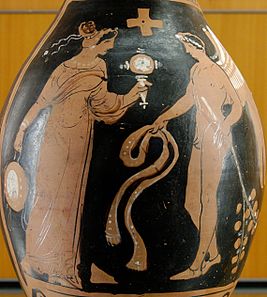
Winged genius facing a woman with a tambourine and mirror, from
southern Italy, about 320 BC.
Nature of the genius
The rational powers and abilities of every human being were attributed to
their soul, which was a genius. Each individual place had a genius
(genius
loci) and so did powerful objects, such as volcanoes. The concept
extended to some specifics: the genius of the theatre, of vineyards, and of
festivals, which made performances successful, grapes grow, and celebrations
succeed, respectively. It was extremely important in the Roman mind to
propitiate the appropriate genii for the major undertakings and events of their
lives.
Specific genii

Bronze genius depicted as
pater familias
(1st century CE)
Although the term genius might apply to any divinity whatsoever, most
of the higher-level and state genii had their own well-established names.
Genius applied most often to individual places or people not generally
known; that is, to the smallest units of society and settlements, families and
their homes. Houses, doors, gates, streets, districts, tribes, each one had its
own genius.The supreme hierarchy of the Roman gods, like that of the
Greeks, was modelled after a human family. It featured a father,
Jupiter
(“father god”), who, in a
patriarchal society
was also the supreme divine
unity, and a mother,
Juno
, queen of the gods. These supreme
unities were subdivided into genii for each individual family; hence, the
genius of each female, representing the female domestic reproductive
power, was a Juno. The male function was a Jupiter.
The juno was worshipped under many titles:
- Iugalis, “of marriage”
- Matronalis, “of married women”
- Pronuba, “of brides”
- Virginalis, “of virginity”
Genii were often viewed as protective spirits, as one would propitiate
them for protection. For example, to protect infants one propitiated a number of
deities concerned with birth and childrearing
:
Cuba (“lying down to sleep”), Cunina (“of the cradle”) and
Rumina (“of breast-feeding”). Certainly, if those genii did not
perform their proper function well, the infant would be in danger.
Hundreds of lararia, or family shrines, have been discovered at
Pompeii
, typically off the
atrium
, kitchen or garden, where the smoke
of burnt offerings could vent through the opening in the roof. A lararium
was distinct from the penus (“within”), another shrine where the
penates
, gods associated with the storerooms,
was located. Each lararium features a panel fresco containing the same
theme: two peripheral figures (Lares)
attend on a central figure (family genius) or two figures (genius
and Juno) who may or may not be at an altar. In the foreground is one or
two serpents crawling toward the genius through a meadow motif.
Campania
and
Calabria
preserved an ancient practice of
keeping a propitious house snake, here linked with the genius. In
another, unrelated fresco (House
of the Centenary) the snake-in-meadow appears below a depiction of
Mount Vesuvius
and is labelled Agathodaimon,
“good
daimon
“, where daimon must be regarded
as the Greek equivalent of genius.
History of the concept
Origin
Etymologically
genius
(“household guardian spirit”) has
the same derivation as nature from
gēns
(“tribe”, “people”) from the
Indo-European
root *gen-, “produce.”
It is the indwelling nature of an object or class of objects or
events that act with a perceived or hypothesized unity. Philosophically the
Romans did not find the paradox of the one being many confusing; like all other
prodigies they attributed it to the inexplicable mystery of divinity. Multiple
events could therefore be attributed to the same and different divinities and a
person could be the same as and different from his genius. They were not
distinct, as the later guardian angels, and yet the Genius Augusti was
not exactly the same as Augustus either. As a natural outcome of these
beliefs, the pleasantness of a place, the strength of an oath, an ability of a
person, were regarded as intrinsic to the object, and yet were all attributable
to genius; hence all of the modern meanings of the word. This point of
view is not attributable to any one civilization; its roots are lost in
prehistory. The Etruscans had such beliefs at the beginning of history, but then
so did the Greeks, the native Italics and many other peoples in the near and
middle east.
Genii under the
monarchy
No literature of the monarchy has survived, but later authors in recounting
its legends mention the genius. For example, under
Servius Tullius
the triplets
Horatii
of Rome fought the triplets Curiatii of
Alba Longa
for the decision of the war that had
arisen between the two communities. Horatius was left standing but his sister,
who had been betrothed to one of the Curiatii, began to keen, breast-beat and
berate Horatius. He executed her, was tried for murder, was acquitted by the
Roman people but the king made him expiate the Juno of his sister and the
Genius Curiatii, a family genius.
Republican genii
The genius appears explicitly in Roman literature relatively late as
early as Plautus
, where one character in the play,
Captivi
, jests that the father of another
is so avaricious that he uses cheap Samian ware in sacrifices to his own
genius, so as not to tempt the genius to steal it.In this passage,
the genius is not identical to the person, as to propitiate oneself would
be absurd, and yet the genius also has the avarice of the person; that
is, the same character, the implication being, like person, like genius.
Implied geniuses date to much earlier; for example, when
Horatius Cocles
defends the
Pons Sublicius
against an Etruscan crossing at
the beginning of the
Roman Republic
, after the bridge is cut down he
prays to the Tiber to bear him up as he swims across: Tiberine pater te,
sancte, precor …, “Holy father Tiber, I pray to you ….” The Tiber so
addressed is a genius. Although the word is not used here, in later
literature it is identified as one.
Horace
describes the genius as “the companion which controls the natal star; the god of
human nature, in that he is mortal for each person, with a changing expression,
white or black”.
Imperial genii
Octavius Caesar
on return to Rome after the
final victory of the
Roman Civil War
at the
Battle of Actium
appeared to the Senate to be a
man of great power and success, clearly a mark of divinity. In recognition of
the prodigy they voted that all banquets should include a libation to his
genius. In concession to this sentiment he chose the name
Augustus
, capturing the numinous meaning of
English “august.” This line of thought was probably behind the later vote in 30
BC that he was divine, as the household cult of the Genius Augusti dates
from that time. It was propitiated at every meal along with the other household
numina.The vote began the tradition of the
divine emperors
; however, the divinity went
with the office and not the man. The Roman emperors gave ample evidence that
they personally were neither immortal nor divine.

Inscription on votive altar to the genius of
Legio VII Gemina
by L. Attius Macro
(CIL
II 5083)
If the genius
of the
imperator
, or commander of all troops, was
to be propitiated, so was that of all the units under his command. The
provincial troops expanded the idea of the genii of state; for example,
from Roman Britain have been found altars to the genii of Roma,
Roman aeterna, Britannia, and to every
legion
,
cohors
,
ala
and
centuria
in Britain, as well as to the
praetorium
of every
castra
and even to the
vexillae
. Inscriptional dedications to
genius were not confined to the military. From
Gallia Cisalpina
under the empire are numerous
dedications to the genii of persons of authority and respect; in addition
to the emperor’s genius principis, were the geniuses of patrons of
freedmen, owners of slaves, patrons of guilds, philanthropists, officials,
villages, other divinities, relatives and friends. Sometimes the dedication is
combined with other words, such as “to the genius and honor” or in the case of
couples, “to the genius and Juno.”
Surviving from the time of the empire hundreds of dedicatory, votive and
sepulchral inscriptions ranging over the entire territory testify to a floruit
of genius worship as an official cult. Stock phrases were abbreviated:
GPR, genio populi Romani (“to the genius of the Roman people”); GHL,
genio huius loci (“to the genius of this place”); GDN, genio domini
nostri (“to the genius of our master”), and so on. In 392 AD with the final
victory of Christianity
Theodosius I
declared the worship of the Genii,
Lares
and
Penates
to be treason, ending their official
terms. The concept, however, continued in representation and speech under
different names or with accepted modifications.
Roman iconography
Coins
The genius of a corporate social body is often a
cameo
theme on ancient coins: a
denarius
from Spain, 76–75 BC, featuring a bust
of the GPR (Genius Populi Romani, “Genius of the Roman People”) on
the
obverse
; an
aureus
of
Siscia
in
Croatia
, 270–275 AD, featuring a standing image
of the GENIUS ILLVR (Genius Exercitus Illyriciani, “Genius of the
Illyrian Army”) on the reverse; an
aureus
of Rome, 134–138 AD, with an image of a
youth holding a cornucopia and patera (sacrificial dish) and the inscription
GENIOPR, genio populi Romani, “to the genius of the Roman people,” on the
reverse.
|
|
|
Scene from Lararium, House of Iulius Polybius, Pompeii
|
|
|
|
Agathodaimon
(“good
divinity”), genius of the soil around Vesuvius
|
|
|
|
Unknown Roman genius near Pompeii, 1st century BC
|
|
Modern-era
representations
|
|
|
Genius of love, Meister des Rosenromans, 1420-1430
|
|
|
|
Genius of victory,
Michelangelo
(1475-1564
|
|
|
|
Genius of
Palermo
, Ignazio Marabitti,
c. 1778
|
|
|
|
Genius of liberty,
Augustin Dumont
, 1801-1884
|
|
|
|
Genius of Alexander, Marie Louise Elisabeth Vigée-Lebrun,
1814
|
|
|
|
Genius of war, Arturo Melida y Alinara (1849-1902)
|

|
Gaius
Valerius Galerius Maximinus (20 November, c. 270 – July/August, 313)
Roman emperor
from 308 to 313, was originally named Daia. He was born
of peasant stock to the half sister of the Roman emperor
Galerius
near their family lands around
Felix Romuliana
; a rural area now in the Danubian region of
Misia
today
Bulgaria, then the newly reorganised Roman province of
Dacia Aureliana
subordinated to the later
Prefecture of Illyricum
).
He rose to high distinction after he had joined the army, and in 305 he was
adopted by his maternal uncle,
Galerius
,
and raised to the rank of
caesar
, with
the government of
Syria
and
Aegyptus
.
In 308, after the elevation of
Licinius
to
Augustus
, Maximinus and
Constantine were
declared filii Augustorum (“sons of the Augusti”), but Maximinus probably
started styling himself after Augustus during a campaign against the
Sassanids
in
310.
On the death of Galerius, in 311, Maximinus divided the Eastern Empire
between Licinius and himself. When Licinius and
Constantine
began to make common cause with one another, Maximinus entered
into a secret alliance with the usurper Caesar
Maxentius
,
who controlled Italy. He came to an open rupture with Licinius in 313, he
summoned an army of 70,000 men, but still sustained a crushing defeat at the
Battle of Tzirallum
, in the neighbourhood of
Heraclea Pontica
, on the April 30, and fled, first to
Nicomedia
and afterwards to
Tarsus
, where he died the following August. His death was variously ascribed
“to despair, to poison, and to the divine justice”.
Maximinus has a bad name in
Christian
annals, as having renewed persecution after the publication of the
toleration edict of Galerius (see
Edict of Toleration by Galerius
).
Eusebius of Caesarea
, for example, writes that Maximinus conceived an
“insane passion” for a Christian girl of
Alexandria
,
who was of noble birth noted for her wealth, education, and virginity – Saint
Catherine of Alexandria
. When the girl refused his advances, he exiled her
and seized all of her wealth and assets.
|














